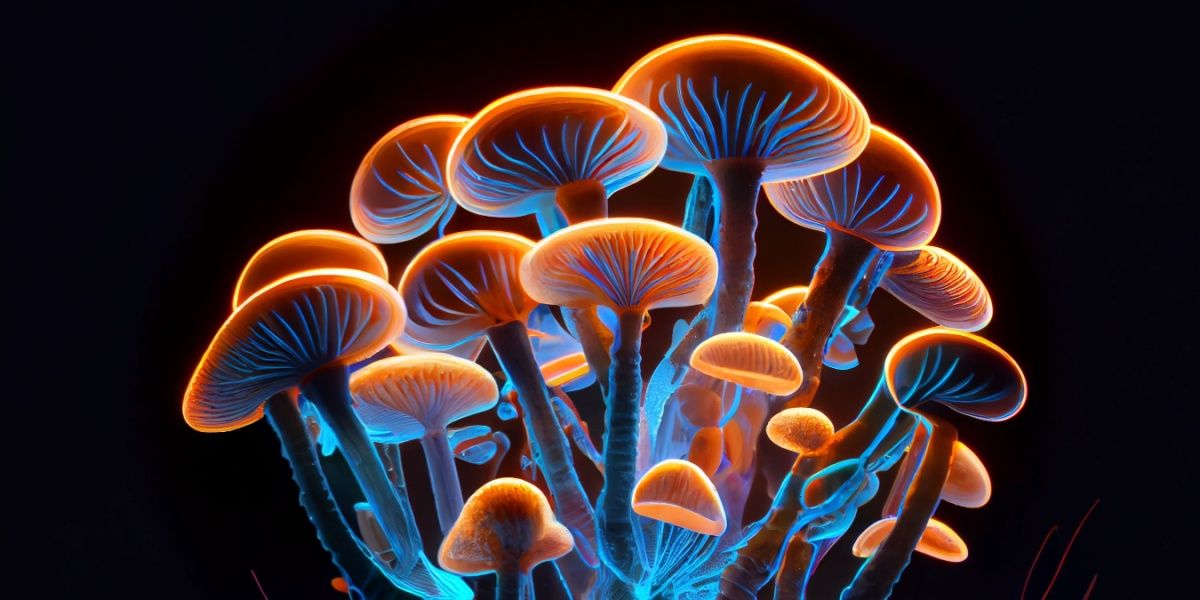N, N-dimethyltryptamine (DMT) is a naturally occurring psychedelic that is found in plants certain, especially the ayahuasca root.[1][2] It is known to produce intense visual hallucinations.
In this article, we’re going to explore what a DMT trip might be like and the common visual phenomena experienced. We’ll also look at the scientific evidence trying to explain why DMT causes these visual hallucinations.
- DMT is a psychedelic drug known to create complex and often profound visual hallucinations.
- DMT appears to work on multiple areas of the brain, including areas specialized for the processing of visual information, which are contained within the visual cortex.
- People taking DMT will frequently experience complex hallucinations that can be consistent across multiple trips. These often feel mystical or spiritual.

What is DMT?
DMT is a psychedelic substance found naturally in a variety of plants and can also be synthesized in a lab.[3] It is classified as a Schedule I drug in the US, meaning that it is considered to have no therapeutic benefits and has a high risk of abuse.
DMT is part of the tryptamine class of drugs, which includes classical or serotonergic hallucinogenic substances. Psilocybin is another example of a tryptamine.[4]
DMT is usually taken through the nose, smoked, or injected. If it is taken orally, it is broken down by monoamine oxidase (MAO) before it is able to have a significant effect. It can be taken orally, for example in an ayahuasca tea, if another substance acts as a MAO inhibitor.[3]
DMT visuals: A deep dive
A DMT trip usually starts very quickly after taking the drug and can last for up to around 45 minutes.[5] During this time, your perception of the world around you will be altered. The exact changes will be different for each person, but auditory and visual hallucinations are common.
During your trip, you might experience a sensation of being outside of your own body, see alterations in your vision while your eyes are open, and experience visions when your eyes are closed.[6]
DMT experiences can be positive, neutral, or negative.
Mechanism behind DMT's visual hallucinations
The exact mechanisms by which DMT is able to produce complex, powerful visual hallucinations is not entirely understood.
DMT acts on 5-HT2A receptors, specifically in the paralimbic and frontal areas of the brain.[7] It also interacts with glutamate receptors in the frontocortical regions, among others.[3] Studies with animals have demonstrated that removing the 5-HT2A receptors prevents the hallucinogenic properties of DMT.[3]
Although it is not clear how DMT’s action on 5-HT2A receptors might create hallucinations, researchers have been able to find specific effects in the visual cortex to explain some visual disturbances.
The population receptive field (pRF) is the size of visual space each tiny area (voxel) of the visual cortex responds to. A small pRF means that each tiny brain area is only responding to things that appear in a very small area of external space. This makes it highly specific. A large pRF means that an area of the brain is responding to things seen in a much wider area, making it less specific.
DMT has been shown to increase the pRF within the visual cortex. This lack of specificity could explain some of the visual effects of a DMT trip, especially a sense of blurriness or visual distortions.[1]
DMT may also selectively impair the brain’s ability to process late-stage visual information.[6] The visual cortex has a clear hierarchy of information, where early stages of processing identify size and position, before then recognizing movement.
Late stages of visual processing include more meaningful aspects of the visual world, such as recognizing different facial expressions or recognizing a whole object. Impairing this late stage of processing allows alternative interpretations of visual stimuli to be activated. Higher-order concepts, such as expectations and understandings of social roles, could also be involved.[6]
In addition to impairing late-stage processing, DMT may enhance early stages of visual processing.[6] This could lead to the reported effects of colours appearing brighter and images more vivid.
Common themes and types of visual experience
Although individuals will have different experiences taking DMT, there are some common themes that many people taking DMT have reported.[6] Most visual effects can be understood as enhancements, transformations, and overlays.[8] Enhancements include seeing colours or patterns as more vivid. Transformations are when objects are changed or altered. Overlays might include a pattern or design appearing over the top of a visual scene.
One such overlay is the presence of patterns and fractals overlaid on the external world during open-eye visual distortions. In more complex hallucinations, waiting rooms and tunnels are common features.
People using DMT may experience complex alternate realities, which can be consistent across multiple trips.[3] These will often include experiences associated with outer space, including alien abduction. These hallucinations can be frightening, but they can also feel comforting or pleasant.
Pleasant trips appear to be more common than unpleasant ones. Many users report meeting a guide or another benevolent entity and communicating with them. Where these guides had a gender, they were more often female than male.
The use of DMT also appears to change the relationship between what you see and your sense of self.[9] Objects, real and hallucinatory, can take on additional meanings.
Factors influencing DMT visuals
The visuals experienced during a DMT trip can depend on many different factors. [9] They are strongly linked to the emotional state of the user. Someone in a more positive mood is more likely to have a pleasant experience than one who is anxious or angry when they take the drug.
Comparison to other psychedelics
DMT has a similar mechanism of action to other common psychedelics, such as LSD or psilocybin.[7] As a result, their effects are also broadly similar, including visual hallucinations, altered states of consciousness, and feelings of connection with a mentor or guide. There are some minor differences, however.
DMT is associated with more complex hallucinations than either LSD or psilocybin. While all three drugs can lead to complex hallucinations, these are more common following DMT use and occur at lower drug doses. Complex hallucinations are also more likely to occur with eyes open and in an undimmed room after using DMT than other psychedelics.[9]
DMT users may be more likely to experience a benevolent, mystical encounter during their trip compared with people who are taking LSD or psilocybin. Given that people taking DMT are more likely to be seeking such an encounter, this may be the result of their expectations rather than an inherent quality of the drug.[10]
A 'bad' trip: Risks and considerations
No drug is without risk. DMT trips are more often positive, but unpleasant or distressing trips are possible, including some that involve encounters with hostile entities. One study of Reddit users found that approximately 30% of trips discussed were negative, although this number may not be accurate because people who had experienced distressing trips wanted to talk about them more.[6]
There are some suggestions that there can be short (less than 6 hours) negative effects, including anxiety and psychosis-like symptoms, but these are rare and short. Often, simple reassurance can allow the person to feel comfortable again.[7]
There have been some reports of people developing psychosis after using DMT, but these reports often involve individuals who have a personal or family history of psychosis and/or use of other drugs. Without other factors, this appears to be very rare.[7]
Preparing for a DMT experience
Your emotional state and mindset have a significant influence on how you experience using DMT. Here are some things that can make a DMT trip safer and increase the chances of having a positive experience:
- Make sure that you are in a safe, reassuring, and comfortable place.
- Have someone around whom you trust and who can seek help in an emergency.
- Avoid taking other drugs at the same time as taking DMT.
- Plan a recovery period during which you don’t need to drive or make important decisions.

-person-thumbnail.jpg?v=1758880627)
-guide-detail.jpg?v=1722503388)
-guide-detail.jpg?v=1756808816)
